Characterization of Asphalt Binder Properties Modified with One-Time Use Masks: Zero Shear Viscosity, Fatigue Life, and Low-Temperature Performance
Abstract
1. Introduction
- To scrutinize the effects of OUM inclusion on the ZSV of asphalt binders by means of steady shear tests.
- To examine the influence of OUM integration within asphalt binder on fatigue performance through the application of the LAS test.
- Using bending beam rheometer methods, this research explores the low-temperature cracking performance of OUM-modified binders (OUMM) through assessment of creep rate and stiffness parameters.
- Utilizing Fourier transform infrared (FTIR) analysis for assessing the influence of OUM application on the functional groups of asphalt samples.
- To explore the impact of OUM on asphalt binder’s storage stability through application of the separation test method.
2. Materials and Test Program
2.1. Raw Materials
2.2. OUMM Preparation
2.3. High-Temperature Performance
2.4. Fatigue Life Assessment
2.5. Low-Temperature Performance
2.6. FTIR Test
2.7. Storage Stability Test
3. Results and Discussion
3.1. ZSV Results
3.2. LAS Results
3.3. BBR Results
3.4. FTIR Analysis
3.5. The Differences in Softening Point
4. Conclusions
- The incorporation of 10% OUM by weight resulted in a seven-fold increase in the binder’s ZSV at 60 °C, indicating a marked improvement in its ability to resist permanent deformation (rutting).
- LAS tests revealed a dramatic improvement in fatigue resistance, with a 168% increase in fatigue life at a 2.5% strain amplitude for the 10% OUM-modified binder. The fatigue life parameter (A) increased significantly, indicating that the polymer network formed by OUM fibers is highly effective at resisting the initiation and propagation of fatigue cracks under repeated traffic loading.
- The significant gains in high-temperature and fatigue properties were offset by a decline in low-temperature performance. BBR tests showed a 55% increase in creep stiffness (S-value) and a 25% decrease in the m-value at −12 °C for the 10% OUM binder, indicating reduced relaxation capability and heightened susceptibility to thermal cracking.
- FTIR analysis suggested that the modification mechanism is primarily a physical process, involving the swelling and dispersion of PP to form a reinforcing network, rather than a chemical reaction. Importantly, modified binders containing up to 10% OUM demonstrated excellent phase stability, ensuring no separation issues during high-temperature storage and handling.
- Based on the balance of performance enhancement and material stability, a modification content of up to 10% OUM (by weight of asphalt) is considered a viable and effective concentration for achieving substantial performance gains without compromising the binder’s homogeneity. The enhanced high-temperature rheological properties indicate that OUM-modified binders are particularly well-suited for application in temperate and hot climates.
- The selection of an optimal OUM concentration is governed by a trade-off between performance, stability, and workability. The upper limit for this study was established at 10% OUM, as preliminary testing revealed that concentrations exceeding this value failed to meet storage stability criteria, indicating an unstable blend unsuitable for practical application. Within the stable 0–10% range, a clear recommendation depends on the intended application. For general use, a modifier content of 4–6% OUM is recommended, as it provides a substantial enhancement in rutting and fatigue resistance while maintaining a moderate impact on low-temperature performance and ensuring a high degree of stability. For specialized, high-stress applications in warmer climates, concentrations approaching the 10% limit may be considered to maximize high-temperature performance, but this must be weighed against the more significant reduction in low-temperature flexibility and the proximity to the stability threshold.
Author Contributions
Funding
Data Availability Statement
Acknowledgments
Conflicts of Interest
References
- Bornand, E.; Letourneux, F.; Deschanvres, C.; Boutoille, D.; Lucet, J.-C.; Lepelletier, D.; Leclere, B.; Mayol, S.; Peiffer-Smadja, N.; Birgand, G. Social representations of mask wearing in the general population during the COVID-19 pandemic. Front. Public Health 2023, 11, 1136980. [Google Scholar] [CrossRef]
- Palcu, J.; Schreier, M.; Janiszewski, C. Facial mask personalization encourages facial mask wearing in times of COVID-19. Sci. Rep. 2022, 12, 891. [Google Scholar] [CrossRef]
- Rab, S.; Javaid, M.; Haleem, A.; Vaishya, R. Face masks are new normal after COVID-19 pandemic. Diabetes Metab. Syndr. Clin. Res. Rev. 2020, 14, 1617–1619. [Google Scholar] [CrossRef]
- Abaluck, J.; Kwong, L.H.; Styczynski, A.; Haque, A.; Kabir, M.A.; Bates-Jefferys, E.; Crawford, E.; Benjamin-Chung, J.; Raihan, S.; Rahman, S.; et al. Impact of community masking on COVID-19: A cluster-randomized trial in Bangladesh. Science 2022, 375, eabi9069. [Google Scholar] [CrossRef]
- Limon, M.R.; Vallente, J.P.C.; Cajigal, A.R.V.; Aquino, M.U.; Aragon, J.A.; Acosta, R.L. Unmasking emerging issues in solid waste management: Knowledge and self-reported practices on the discarded disposable masks during the COVID-19 pandemic in the Philippines. Environ. Chall. 2022, 6, 100435. [Google Scholar] [CrossRef]
- Petrescu, D.C.; Rastegari, H.; Petrescu-Mag, I.V.; Petrescu-Mag, R.M. Determinants of proper disposal of single-use masks: Knowledge, perception, behavior, and intervention measures. PeerJ 2023, 11, e15104. [Google Scholar] [CrossRef]
- Singh, N.; Tang, Y.; Ogunseitan, O.A. Environmentally Sustainable Management of Used Personal Protective Equipment. Environ. Sci. Technol. 2020, 54, 8500–8502. [Google Scholar] [CrossRef]
- Kilmartin-Lynch, S.; Roychand, R.; Saberian, M.; Li, J.; Zhang, G. Application of COVID-19 single-use shredded nitrile gloves in structural concrete: Case study from Australia. Sci. Total Environ. 2022, 812, 151423. [Google Scholar] [CrossRef]
- Chowdhury, H.; Chowdhury, T.; Sait, S.M. Estimating marine plastic pollution from COVID-19 face masks in coastal regions. Mar. Pollut. Bull. 2021, 168, 112419. [Google Scholar] [CrossRef]
- Xu, G.; Jiang, H.; Stapelberg, M.; Zhou, J.; Liu, M.; Li, Q.-J.; Cao, Y.; Gao, R.; Cai, M.; Qiao, J.; et al. Self-Perpetuating Carbon Foam Microwave Plasma Conversion of Hydrocarbon Wastes into Useful Fuels and Chemicals. Environ. Sci. Technol. 2021, 55, 6239–6247. [Google Scholar] [CrossRef]
- Ali, M.; Opulencia, M.J.C.; Chandra, T.; Chandra, S.; Muda, I.; Dias, R.; Chetthamrongchai, P.; Jalil, A.T. An Environmentally Friendly Solution for Waste Facial Masks Recycled in Construction Materials. Sustainability 2022, 14, 8739. [Google Scholar] [CrossRef]
- Webb, H.K.; Arnott, J.; Crawford, R.J.; Ivanova, E.P. Plastic Degradation and Its Environmental Implications with Special Reference to Poly(ethylene terephthalate). Polymers 2013, 5, 1–18. [Google Scholar] [CrossRef]
- Patrício Silva, A.L.; Prata, J.C.; Walker, T.R.; Duarte, A.C.; Ouyang, W.; Barcelò, D.; Rocha-Santos, T. Increased plastic pollution due to COVID-19 pandemic: Challenges and recommendations. Chem. Eng. J. 2021, 405, 126683. [Google Scholar] [CrossRef]
- Du, H.; Huang, S.; Wang, J. Environmental risks of polymer materials from disposable face masks linked to the COVID-19 pandemic. Sci. Total Environ. 2022, 815, 152980. [Google Scholar] [CrossRef]
- Kwak, J.I.; An, Y.-J. Post COVID-19 pandemic: Biofragmentation and soil ecotoxicological effects of microplastics derived from face masks. J. Hazard. Mater. 2021, 416, 126169. [Google Scholar] [CrossRef]
- Ahmedzade, P.; Demirelli, K.; Günay, T.; Biryan, F.; Alqudah, O. Effects of Waste Polypropylene Additive on the Properties of Bituminous Binder. Procedia Manuf. 2015, 2, 165–170. [Google Scholar] [CrossRef]
- Ayash, A.A.; Raouf, R.M.; Eweed, K.M. Mechanical Characteristics of Asphalt Mixture Modified by Polypropylene Waste. Proc. Defect Diffus. Forum 2020, 398, 90–97. [Google Scholar] [CrossRef]
- Al-Hadidy, A.-R.I. Evaluation of pyrolisis polypropylene modified asphalt paving materials. Al-Rafidain Eng. J. 2006, 14, 36–50. [Google Scholar]
- Al-Hadidy, A.I.; Yi-Qiu, T. Mechanistic approach for polypropylene-modified flexible pavements. Mater. Des. 2009, 30, 1133–1140. [Google Scholar] [CrossRef]
- Cheng, Y.; Fu, Q.; Fang, C.; Zhang, Q.; Lu, C. Preparation, Structure, and Properties of Modified Asphalt with Waste Packaging Polypropylene and Organic Rectorite. Adv. Mater. Sci. Eng. 2019, 2019, 5362795. [Google Scholar] [CrossRef]
- Qadir, A. Rutting performance of polypropylene modified asphalt concrete. Int. J. Civ. Eng. 2014, 12, 304–312. [Google Scholar]
- Tapkın, S. Optimal polypropylene fiber amount determination by using gyratory compaction, static creep and Marshall stability and flow analyses. Constr. Build. Mater. 2013, 44, 399–410. [Google Scholar] [CrossRef]
- Wang, S.; Mallick, R.B.; Rahbar, N. Toughening mechanisms in polypropylene fiber-reinforced asphalt mastic at low temperature. Constr. Build. Mater. 2020, 248, 118690. [Google Scholar] [CrossRef]
- Vamegh, M.; Ameri, M.; Chavoshian Naeni, S.F. Experimental investigation of effect of PP/SBR polymer blends on the moisture resistance and rutting performance of asphalt mixtures. Constr. Build. Mater. 2020, 253, 119197. [Google Scholar] [CrossRef]
- Al-Hadidy, A.I. Engineering behavior of aged polypropylene-modified asphalt pavements. Constr. Build. Mater. 2018, 191, 187–192. [Google Scholar] [CrossRef]
- Shi, X.; Younho, R.; Enrique, I.; Chang-Seon, S.; Stenger, E.M.; Park, P. Effects of thermally modified asphalt concrete on pavement temperature. Int. J. Pavement Eng. 2019, 20, 669–681. [Google Scholar] [CrossRef]
- Emtiaz, M.; Imtiyaz, M.N.; Majumder, M.; Idris, I.I.; Mazumder, R.; Rahaman, M.M. A Comprehensive Literature Review on Polymer-Modified Asphalt Binder. CivilEng 2023, 4, 901–932. [Google Scholar] [CrossRef]
- Masri, T.D.K.A.; Ferdaus, R.; Ramadhansyah, P.J. Sustainable Use of Polymer in Asphalt Mixture: A Review. Construction 2022, 2, 12–21. [Google Scholar] [CrossRef]
- Habbouche, J.; Boz, I.; Diefenderfer, B.K.; Smith, B.C.; Adel, S.H. State of the Practice for High Polymer-Modified Asphalt Binders and Mixtures. Transp. Res. Rec. 2021, 2675, 235–247. [Google Scholar] [CrossRef]
- Kaya Ozdemir, D.; McNally, T. Recycling of Polymer Components from Waste Face Masks for Asphalt Modification: A Mini Review. J. Appl. Polym. Sci. 2025, e57972. [Google Scholar] [CrossRef]
- Monticelli, R.; Roberto, A.; Romeo, E.; Tebaldi, G. Mixed Design Optimization of Polymer-Modified Asphalt Mixtures (PMAs) Containing Carton Plastic Packaging Wastes. Sustainability 2023, 15, 10574. [Google Scholar] [CrossRef]
- Dong, F.; Jiang, Y.; Yu, X.; Wang, S.; Jin, Y.; Lu, J.; Wan, L.; Li, Z. Improvement of compatibility, thermal stability, and rheological properties of composite modified asphalt based on molecular gradient design. Case Stud. Constr. Mater. 2024, 21, e03632. [Google Scholar] [CrossRef]
- Ma, Y.; Zhou, H.; Jiang, X.; Polaczyk, P.; Xiao, R.; Zhang, M.; Huang, B. The utilization of waste plastics in asphalt pavements: A review. Clean. Mater. 2021, 2, 100031. [Google Scholar] [CrossRef]
- Kim, Y.-M.; Kim, K.; Le, T.H.M. Advancing Sustainability and Performance with Crushed Bottom Ash as Filler in Polymer-Modified Asphalt Concrete Mixtures. Polymers 2024, 16, 1683. [Google Scholar] [CrossRef]
- Kumar, B.; Kumar, N. Enhancing asphalt mixture performance through waste plastic modification: A comprehensive analysis of optimal compositions and volumetric properties. J. Struct. Integr. Maint. 2024, 9, 2376804. [Google Scholar] [CrossRef]
- Khan, D.; Khan, R.; Khan, M.T.; Alam, M.; Hassan, T. Performance of hot-mix asphalt using polymer-modified bitumen and marble dust as a filler. J. Traffic Transp. Eng. 2023, 10, 385–398. [Google Scholar] [CrossRef]
- Alnadish, A.M.; Katman, H.Y.B.; Ibrahim, M.R.; Gamil, Y.; Mashaan, N.S. A bibliometric analysis and review on the performance of polymer-modified bitumen. Front. Mater. 2023, 10, 2023. [Google Scholar] [CrossRef]
- Chen, Z.; Leng, Z.; Jiao, Y.; Xu, F.; Lin, J.; Wang, H.; Cai, J.; Zhu, L.; Zhang, Y.; Feng, N.; et al. Innovative use of industrially produced steel slag powders in asphalt mixture to replace mineral fillers. J. Clean. Prod. 2022, 344, 131124. [Google Scholar] [CrossRef]
- Ma, Y.; Wang, S.; Zhou, H.; Hu, W.; Polaczyk, P.; Huang, B. Recycled polyethylene and crumb rubber composites modified asphalt with improved aging resistance and thermal stability. J. Clean. Prod. 2022, 334, 130102. [Google Scholar] [CrossRef]
- Saboo, N.; Kumar, P. Analysis of Different Test Methods for Quantifying Rutting Susceptibility of Asphalt Binders. J. Mater. Civ. Eng. 2016, 28, 04016024. [Google Scholar] [CrossRef]
- Shafabakhsh, G.; Mana, M.; Mahdi, F.; Isazadeh, M. Experimental investigation of the effect of asphalt binder modified with nanosilica on the rutting, fatigue and performance grade. Pet. Sci. Technol. 2019, 37, 1495–1500. [Google Scholar] [CrossRef]
- Zhong, Y.L.; Tian, Z.; Simon, G.P.; Li, D. Scalable production of graphene via wet chemistry: Progress and challenges. Mater. Today 2015, 18, 73–78. [Google Scholar] [CrossRef]
- Ziari, H.; Amini, A.; Goli, A.; Mirzaiyan, D. Predicting rutting performance of carbon nano tube (CNT) asphalt binders using regression models and neural networks. Constr. Build. Mater. 2018, 160, 415–426. [Google Scholar] [CrossRef]
- Shenoy, A. Model-Fitting the Master Curves of the Dynamic Shear Rheometer Data to Extract a Rut-controlling Term for Asphalt Pavements. J. Test. Eval. 2002, 30, 95–102. [Google Scholar] [CrossRef]
- Biro, S.; Gandhi, T.; Amirkhanian, S. Determination of zero shear viscosity of warm asphalt binders. Constr. Build. Mater. 2009, 23, 2080–2086. [Google Scholar] [CrossRef]
- Rowe, G.M.; D’Angelo, J.A.; Sharrock, M.J. Use of the zero shear viscosity as a parameter for the high temperature binder specification parameter. J. Appl. Asph. Bind. Technol. 2002, 2, 2. [Google Scholar]
- Giuliani, F.; Merusi, F.; Antunes, I. Creep flow behavior of asphalt rubber binder. The zero-shear viscosity analysis. In Proceedings of the Asphalt Rubber Conference, Parma, Italy, 25 October 2006; pp. 1–13. [Google Scholar]
- Xu, J.; Gong, Y.; Chen, L.-B.; Ma, T.; Zeng, J.-C.; Yan, E.-H.; Xiao, G.-S. High-Temperature Performance of Asphalt Mixtures: Preliminary Analysis for the Standard Technical Index Based on Gray Relational Analysis Method. Adv. Mater. Sci. Eng. 2020, 2020, 5818036. [Google Scholar] [CrossRef]
- Rahi, M.; Fini, E.H.; Hajikarimi, P.; Nejad, F.M. Rutting Characteristics of Styrene-Ethylene/Propylene-Styrene Polymer Modified Asphalt. J. Mater. Civ. Eng. 2015, 27, 04014154. [Google Scholar] [CrossRef]
- Notani, M.A.; Mokhtarnejad, M. Investigating the rheological and self-healing capability of toner-modified asphalt binder. Proc. Inst. Civ. Eng. Constr. Mater. 2018, 173, 123–131. [Google Scholar] [CrossRef]
- Shenoy, A. Fatigue Testing and Evaluation of Asphalt Binders Using the Dynamic Shear Rheometer. J. Test. Eval. 2002, 30, 303–312. [Google Scholar] [CrossRef]
- Faxina, A.L.; Sória, M.H.A.; Fabbri, G.T.P.; Leite, L.F.M. Fatigue Behavior of Asphalt-rubber Binders Modified With Shale-oil Residue. Pet. Sci. Technol. 2014, 32, 1617–1625. [Google Scholar] [CrossRef]
- Behl, A.; Bharath, G.; Chandra, S. Characterization of Fatigue Resistance of Warm Mix Binders Using Linear Amplitude Sweep Test. Int. J. Pavement Res. Technol. 2022, 15, 433–441. [Google Scholar] [CrossRef]
- Hajj, R.; Bhasin, A. The search for a measure of fatigue cracking in asphalt binders—A review of different approaches. Int. J. Pavement Eng. 2018, 19, 205–219. [Google Scholar] [CrossRef]
- Anderson, D.A.; Le Hir, Y.M.; Marasteanu, M.O.; Planche, J.-P.; Martin, D.; Gauthier, G. Evaluation of Fatigue Criteria for Asphalt Binders. Transp. Res. Rec. 2001, 1766, 48–56. [Google Scholar] [CrossRef]
- Hu, Y.; Sreeram, A.; Bahia, H.U.; Airey, G.D.; Si, W.; Li, B.; Xu, X. Assessing correlations between two linear amplitude sweep (LAS) standards for evaluating the fatigue properties of aged bitumen. Int. J. Pavement Eng. 2024, 25, 2375419. [Google Scholar] [CrossRef]
- Akhil, M.; Sreelatha, T. Fatigue Analysis of Coir Powder Modified Bitumen Using Linear Amplitude Sweep Test. AIJR Proc. 2025, 322–329. [Google Scholar] [CrossRef]
- Lee, H.-J.; Kim, Y.R. Viscoelastic Constitutive Model for Asphalt Concrete under Cyclic Loading. J. Eng. Mech. 1998, 124, 32–40. [Google Scholar] [CrossRef]
- Schapery, R.A. Correspondence principles and a generalizedJ integral for large deformation and fracture analysis of viscoelastic media. Int. J. Fract. 1984, 25, 195–223. [Google Scholar] [CrossRef]
- Hintz, C.; Velasquez, R.; Johnson, C.; Bahia, H. Modification and Validation of Linear Amplitude Sweep Test for Binder Fatigue Specification. Transp. Res. Rec. 2011, 2207, 99–106. [Google Scholar] [CrossRef]
- Gong, X.; Ma, J.; Qian, G.; Li, X.; Zhong, C. Correlation analysis of hot-mix asphalt and dense fine aggregate matrix properties under varying freeze-thaw cycles. Constr. Build. Mater. 2024, 450, 138632. [Google Scholar] [CrossRef]
- Li, L.; Guo, Z.; Ran, L.; Zhang, J. Study on Low-Temperature Cracking Performance of Asphalt under Heat and Light Together Conditions. Materials 2020, 13, 1541. [Google Scholar] [CrossRef]
- Mahmood, A.O.; Kattan, R.A. Experimental Analysis to Evaluate the Impact of Styrene-Butadiene-Styrene and Crumb Rubber on the Rutting and Moisture Resistance of Asphalt Mixtures. Sustainability 2023, 15, 10387. [Google Scholar] [CrossRef]
- ASTM D6648–08; Standard Test Method for Determining the Flexural Creep Stiffness of Asphalt binder Using the Bending Beam Rheometer (BBR). ASTM International: West Conshohocken, PA, USA, 2008.
- Putra, I.G.A.A.; Thanaya, I.N.A.; Ariawan, I.M.A.; Ciawi, Y. Repurposing mask waste as a sustainable additive for enhancing asphalt mixtures. In Proceedings of the International Conference on Innovations in Social Sciences Education and Engineering, Istanbul, Turkey, 30 December 2023; p. 88. [Google Scholar]
- Wang, G.; Massarra, C.C. Beyond COVID-19: Integrating Disposable Face Masks in Asphalt to Combat Plastic Waste and Improve Pavement Resilience. In Proceedings of the CIB Conferences, West Lafayette, IN, USA, 19–23 May 2025; p. 279. [Google Scholar]
- Abdullh, M. Reinforcement of Asphalt Concrete Mixture Using Polypropylene Fibers. Syr. J. Sci. Innov. 2024, 2, 2. [Google Scholar]
- Abdelmagid, A.A.A.; Jin, G.; Chen, G.; Huang, B.; Li, Y.; Idriss, A.I.B. High-Temperature Performance Enhancement of Asphalt Binders Modified with Single-Use Masks: A Rheological Analysis with Predictive Modeling. Polymers 2025, 17, 1746. [Google Scholar] [CrossRef]
- De Visscher, J.; Vanelstraete, A. Practical test methods for measuring the zero shear viscosity of bituminous binders. Mater. Struct. 2004, 37, 360–364. [Google Scholar] [CrossRef]
- Liu, G.; Wu, S.; de Ven, M.v.; Yu, J.; Molenaar, A. Influence of sodium and organo-montmorillonites on the properties of bitumen. Appl. Clay Sci. 2010, 49, 69–73. [Google Scholar] [CrossRef]
- Polacco, G.; Filippi, S.; Merusi, F.; Stastna, G. A review of the fundamentals of polymer-modified asphalts: Asphalt/polymer interactions and principles of compatibility. Adv. Colloid Interface Sci. 2015, 224, 72–112. [Google Scholar] [CrossRef]
- Yildirim, Y. Polymer modified asphalt binders. Constr. Build. Mater. 2007, 21, 66–72. [Google Scholar] [CrossRef]
- D’Angelo, J.; Kluttz, R.; Dongre, R.N.; Stephens, K.; Zanzotto, L. Revision of the superpave high temperature binder specification: The multiple stress creep recovery test (with discussion). J. Assoc. Asph. Paving Technol. 2007, 76, 132–162. [Google Scholar]
- Airey, G.D. Rheological properties of styrene butadiene styrene polymer modified road bitumens☆. Fuel 2003, 82, 1709–1719. [Google Scholar] [CrossRef]
- Yang, Q.; Lin, J.; Wang, X.; Wang, D.; Xie, N.; Shi, X. A review of polymer-modified asphalt binder: Modification mechanisms and mechanical properties. Clean. Mater. 2024, 12, 100255. [Google Scholar] [CrossRef]
- Liu, Z.; Li, S.; Wang, Y. Waste engine oil and polyphosphoric acid enhanced the sustainable self-healing of asphalt binder and its fatigue behavior. J. Clean. Prod. 2022, 339, 130767. [Google Scholar] [CrossRef]
- Abtahi, S.M.; Sheikhzadeh, M.; Hejazi, S.M. Fiber-reinforced asphalt-concrete—A review. Constr. Build. Mater. 2010, 24, 871–877. [Google Scholar] [CrossRef]
- Masad, E.; Somadevan, N.; Bahia, H.U.; Kose, S. Modeling and Experimental Measurements of Strain Distribution in Asphalt Mixes. J. Transp. Eng. 2001, 127, 477–485. [Google Scholar] [CrossRef]
- Bahia, H.; Tabatabaee, H.A.; Mandal, T.; Faheem, A. Field Evaluation of Wisconsin Modified Binder Selection Guidelines-Phase II; Wisconsin Highway Research Program; University of Wisconsin: Madison, WI, USA, 2013. [Google Scholar]
- Xue, Y.; Wu, S.; Cai, J.; Zhou, M.; Zha, J. Effects of two biomass ashes on asphalt binder: Dynamic shear rheological characteristic analysis. Constr. Build. Mater. 2014, 56, 7–15. [Google Scholar] [CrossRef]
- Yaro, N.S.A.; Sutanto, M.H.; Habib, N.Z.; Napiah, M.; Usman, A.; Muhammad, A. Comparison of Response Surface Methodology and Artificial Neural Network approach in predicting the performance and properties of palm oil clinker fine modified asphalt mixtures. Constr. Build. Mater. 2022, 324, 126618. [Google Scholar] [CrossRef]

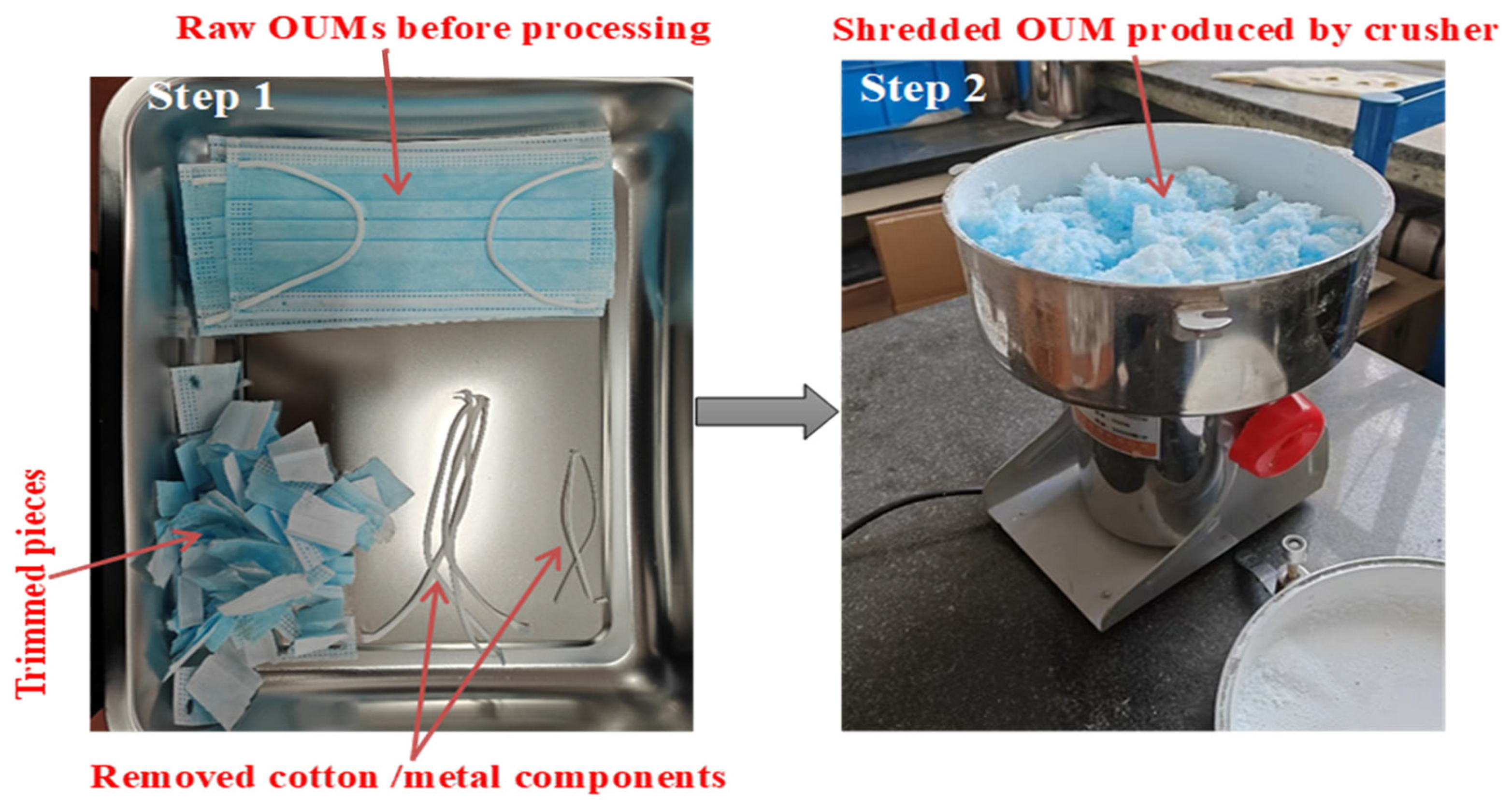

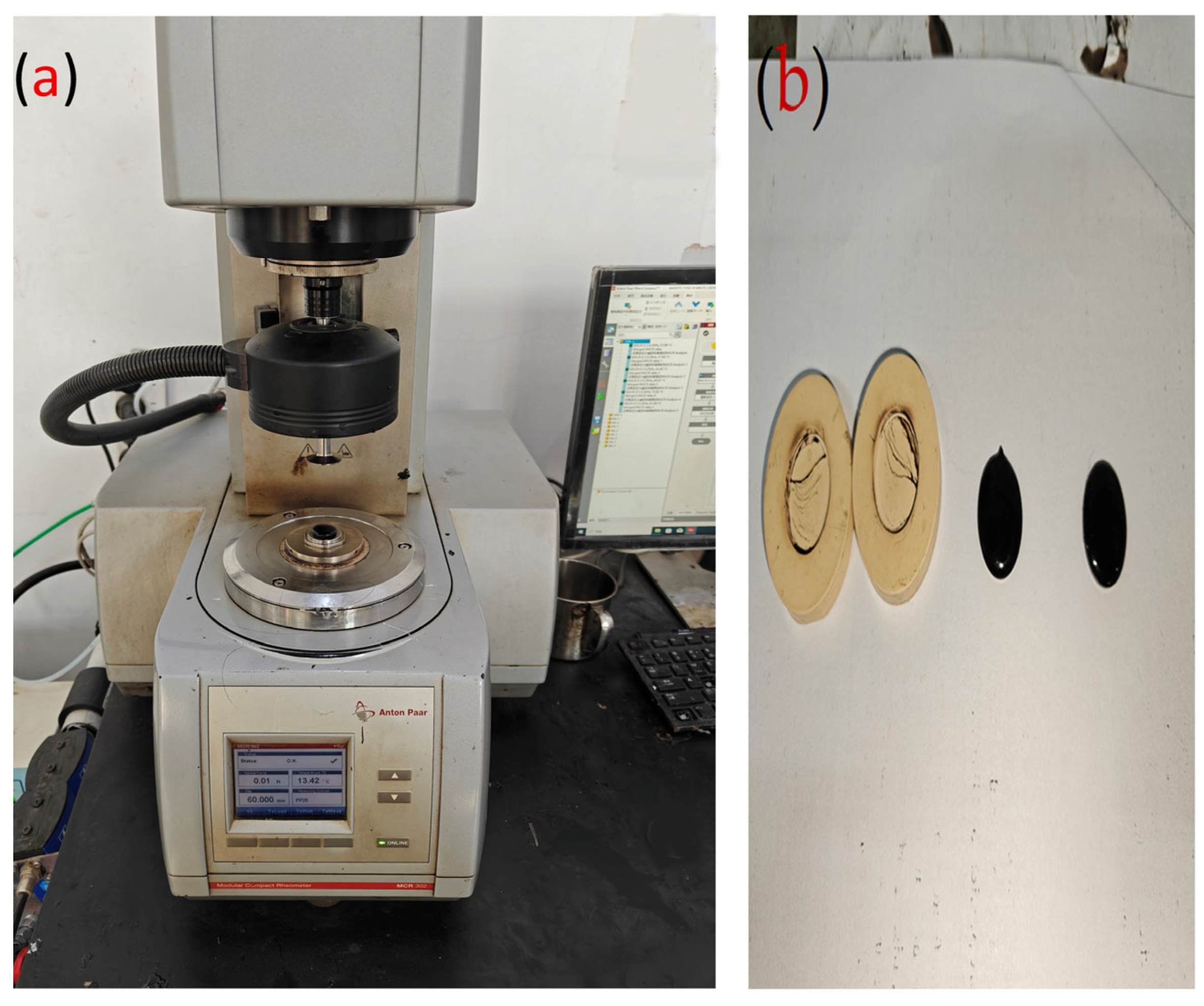
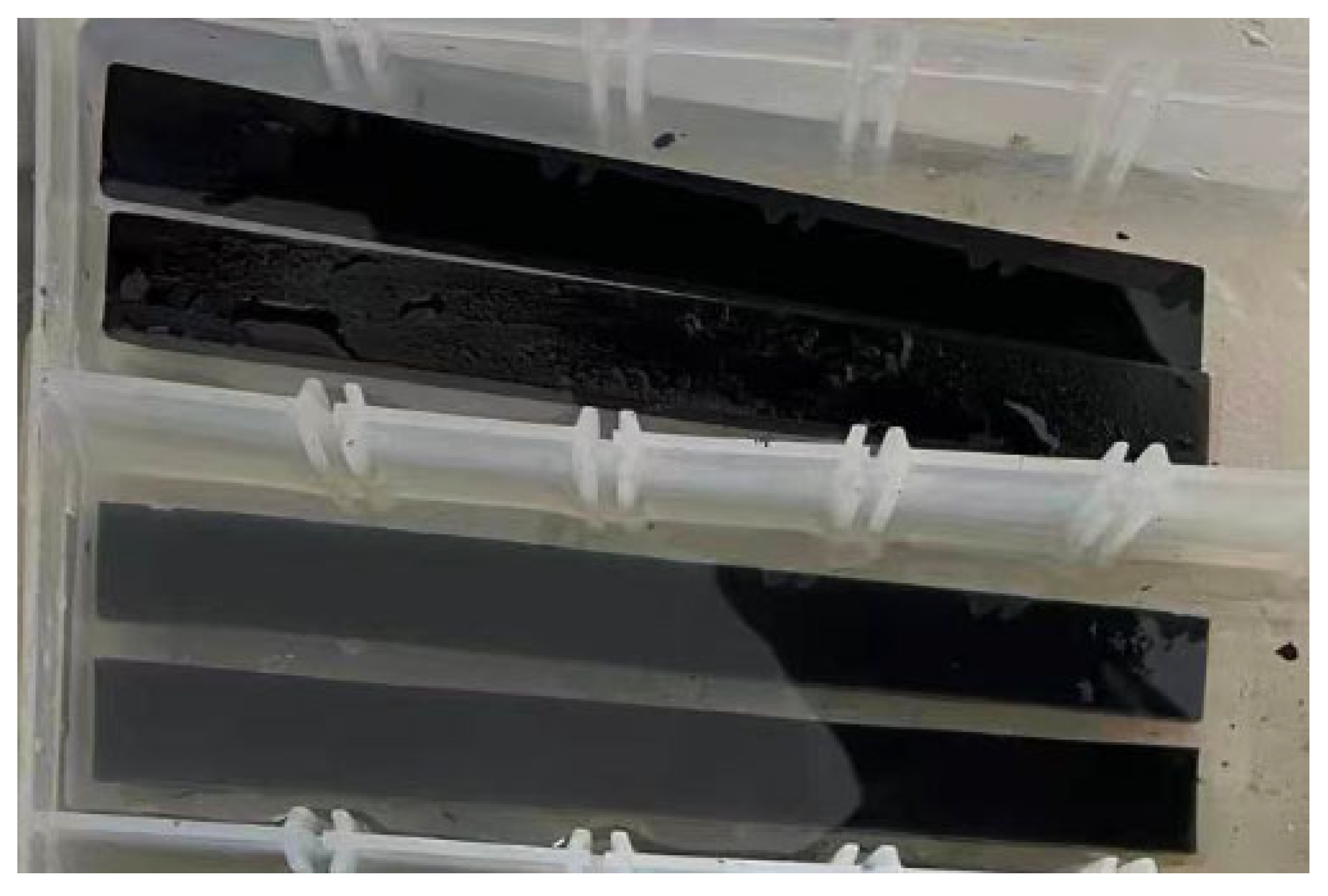
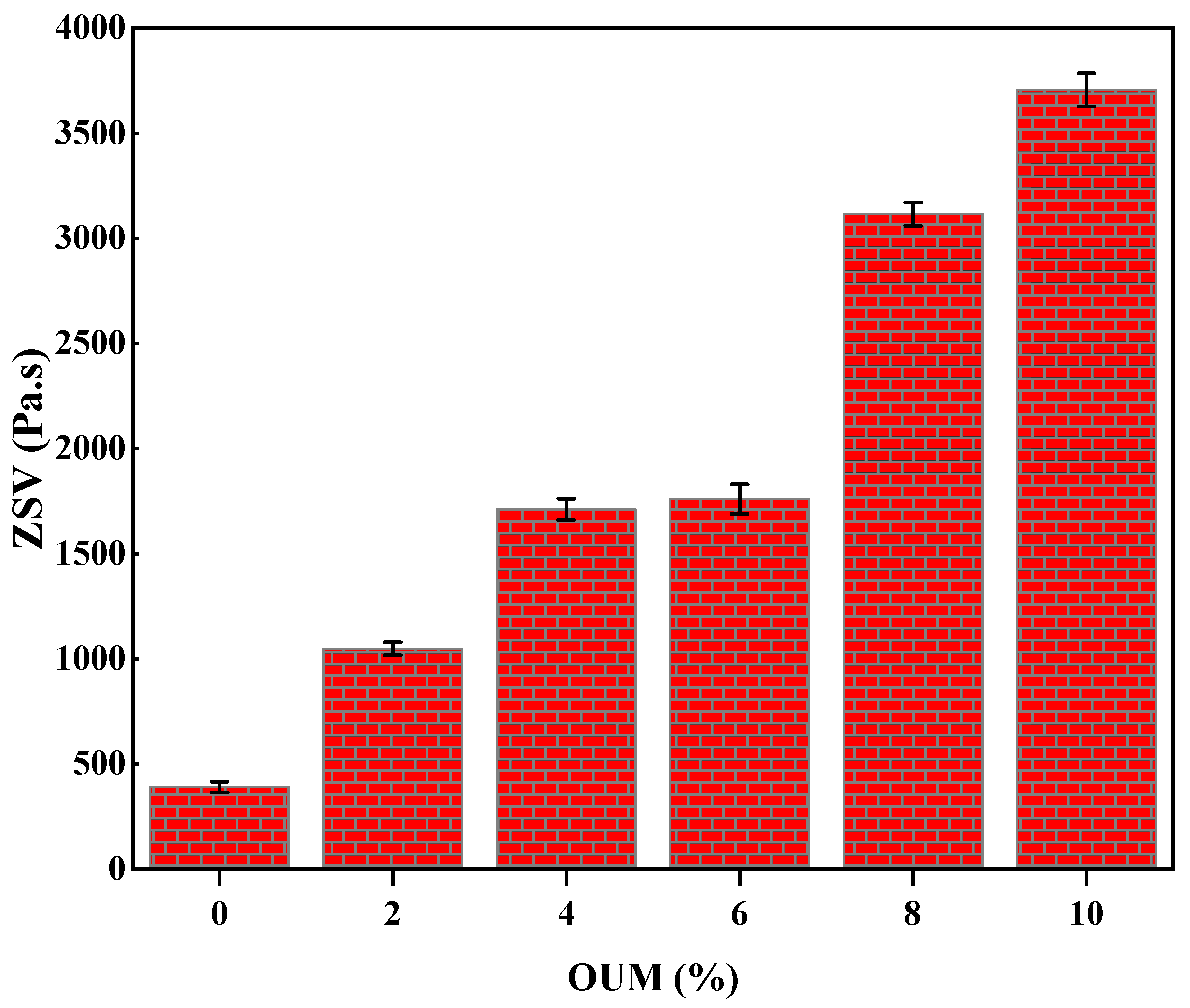
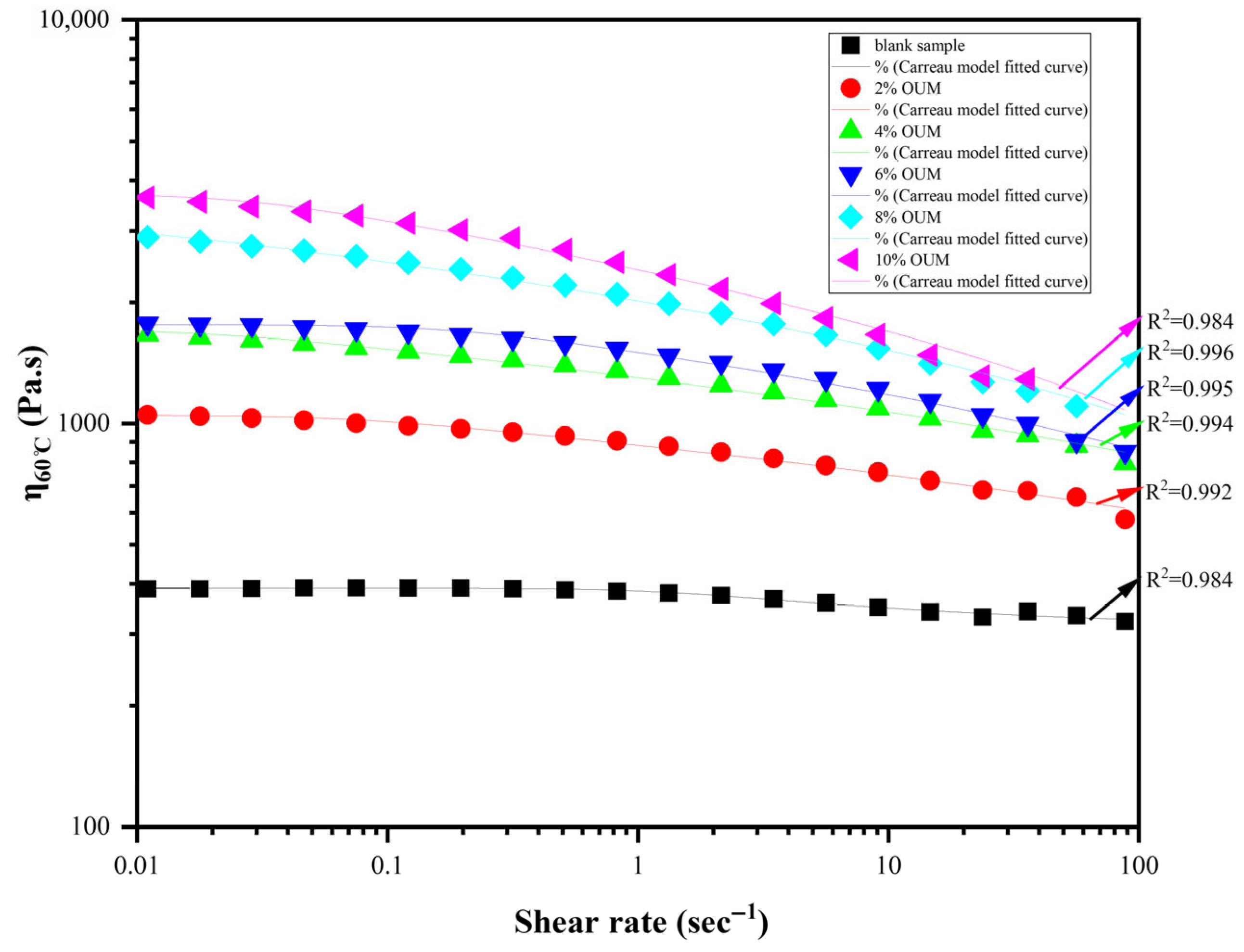
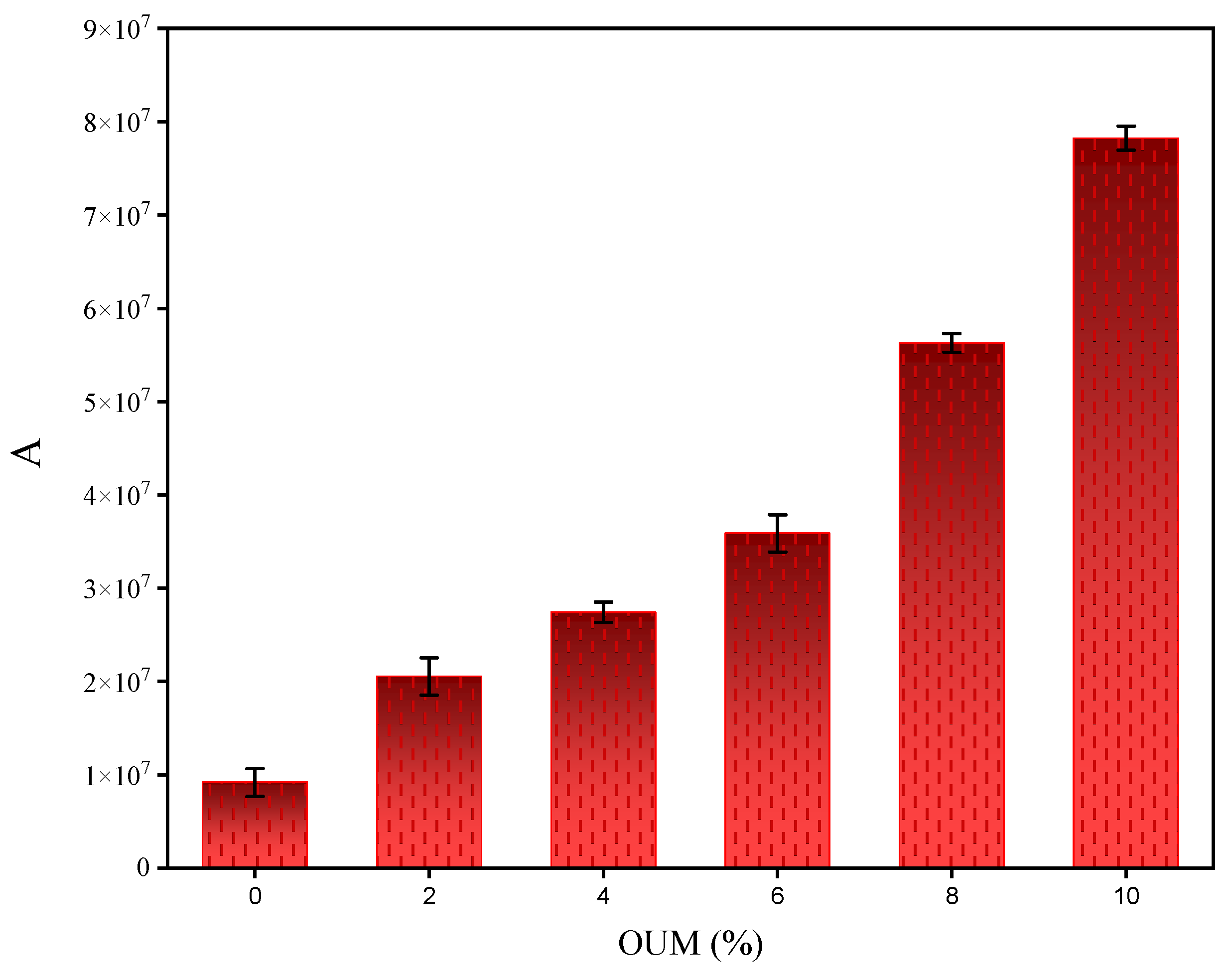
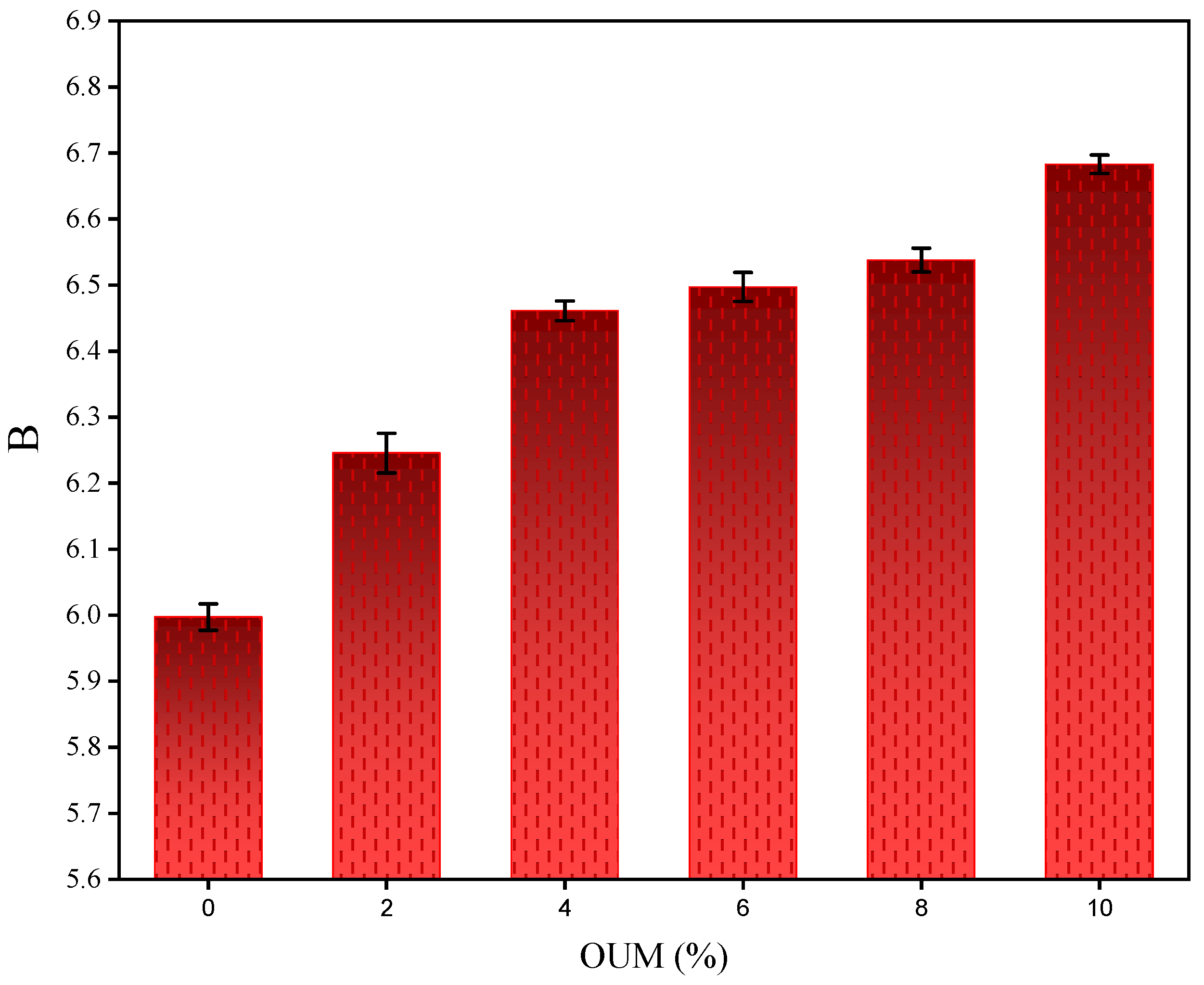
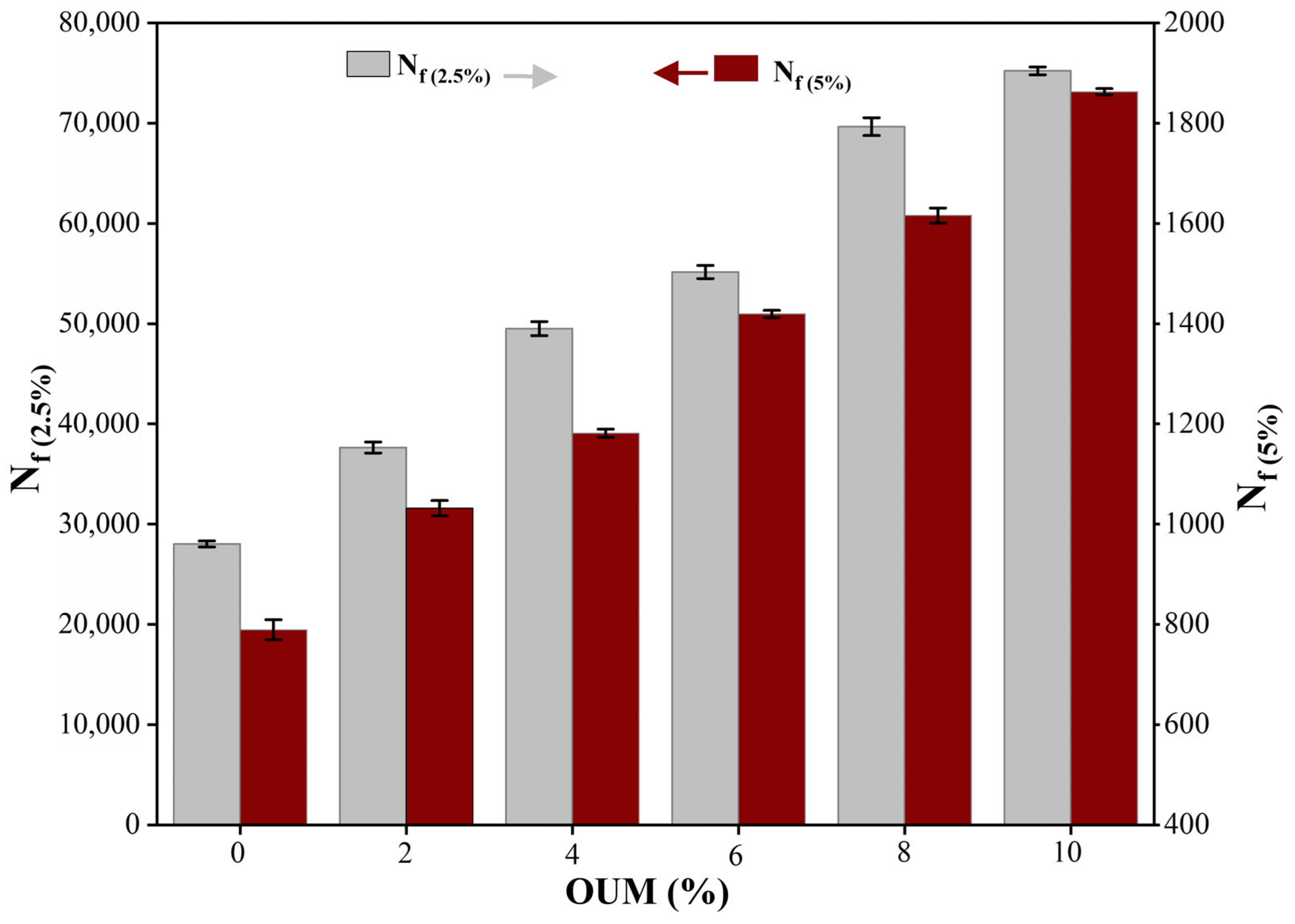
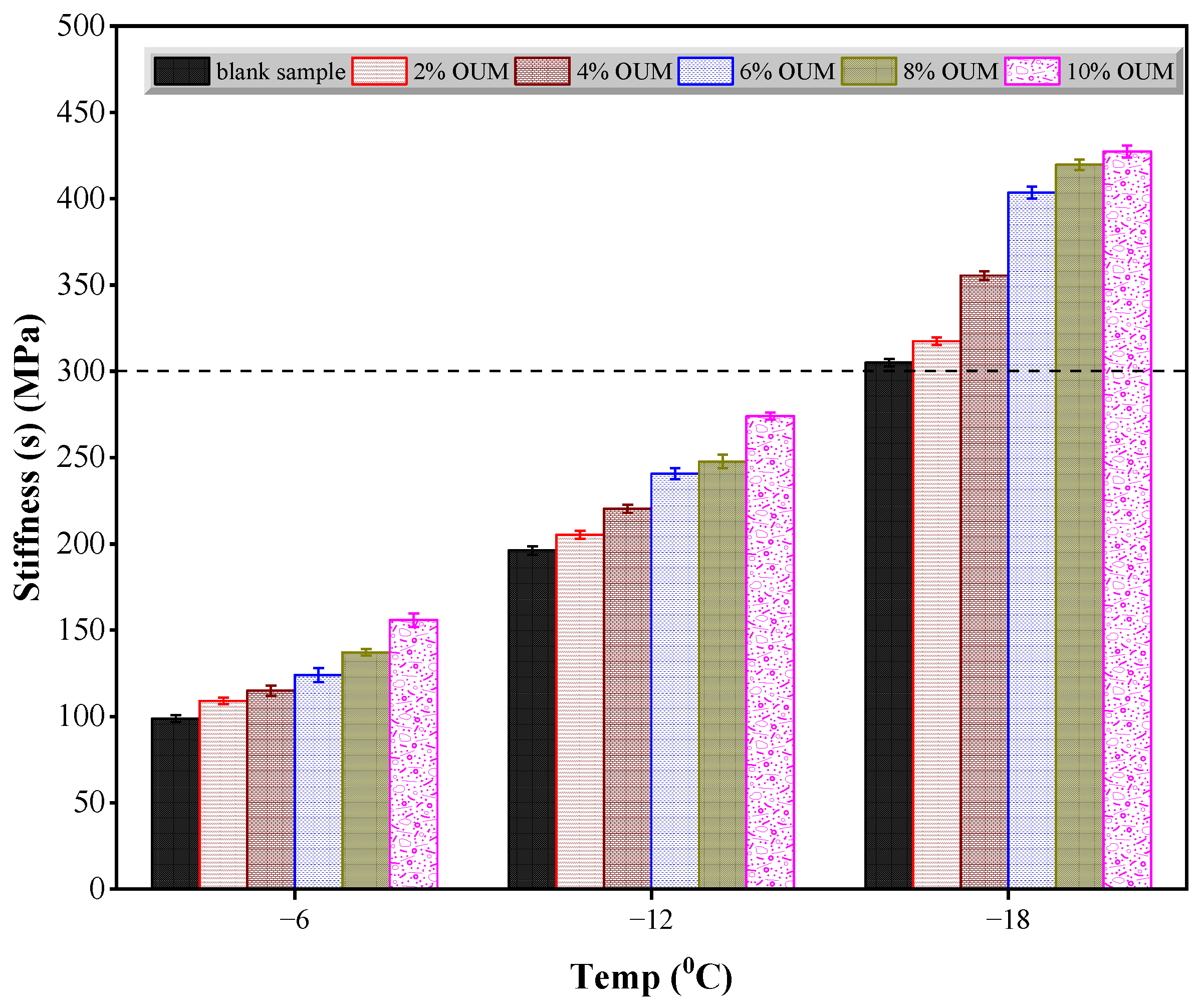
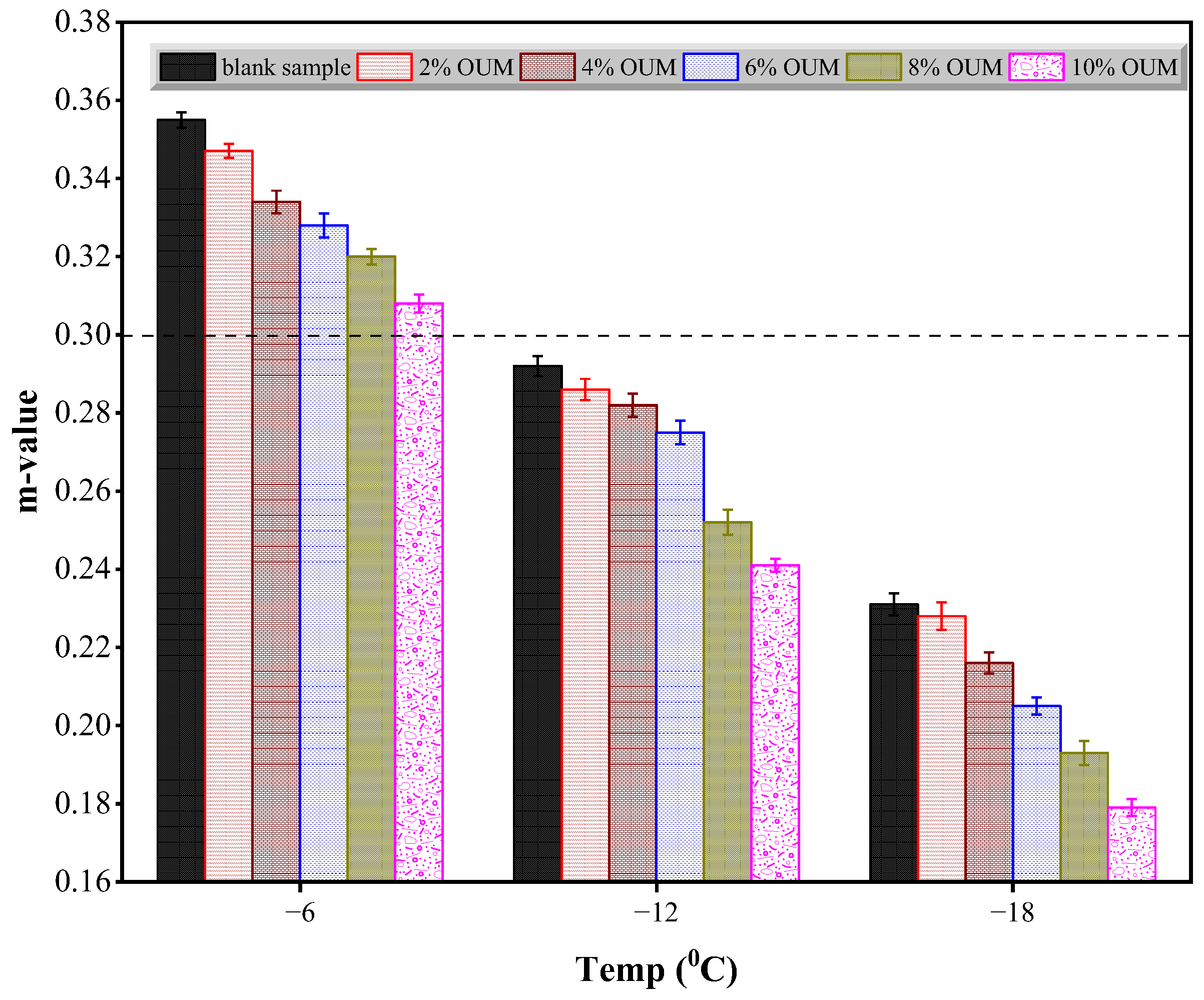
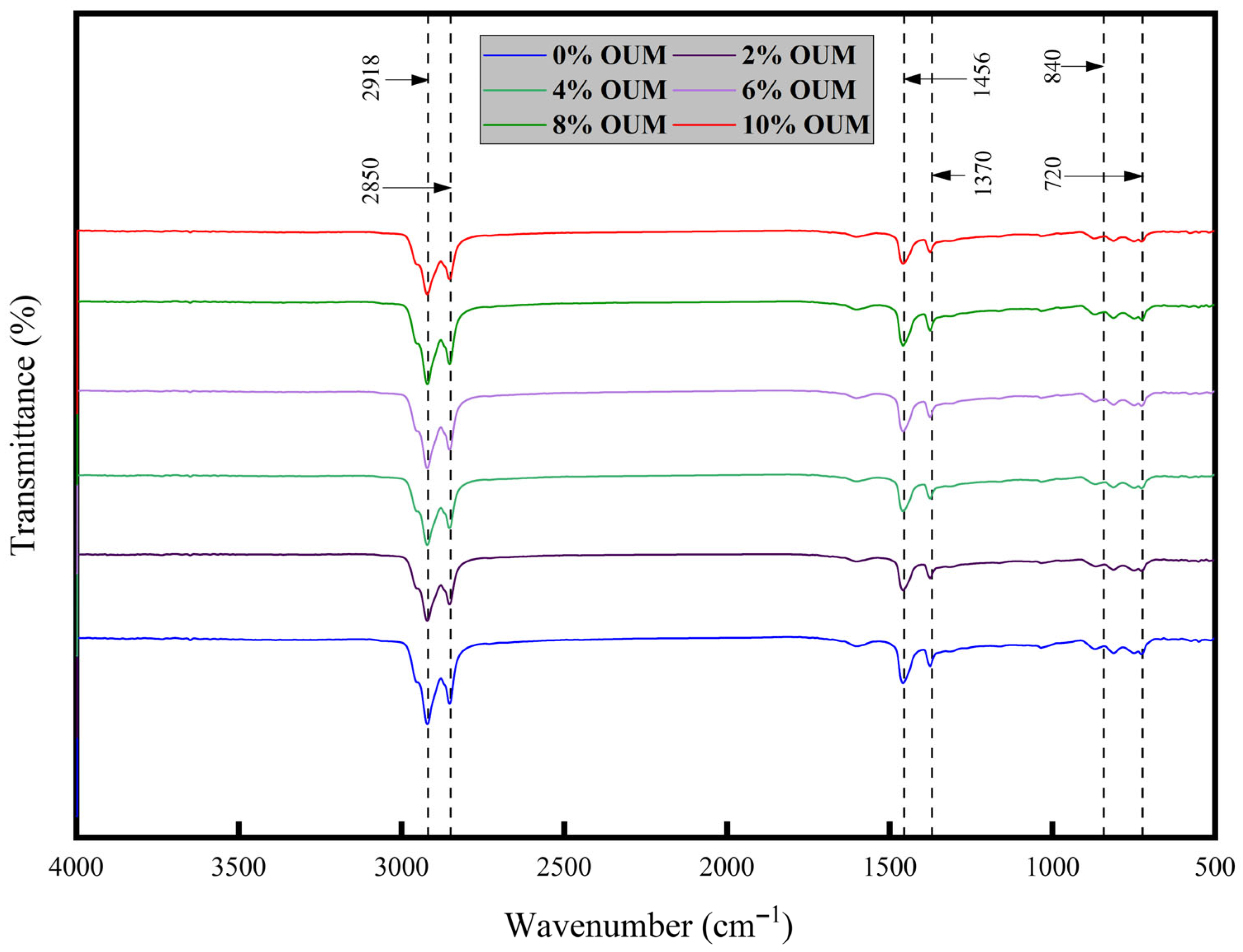
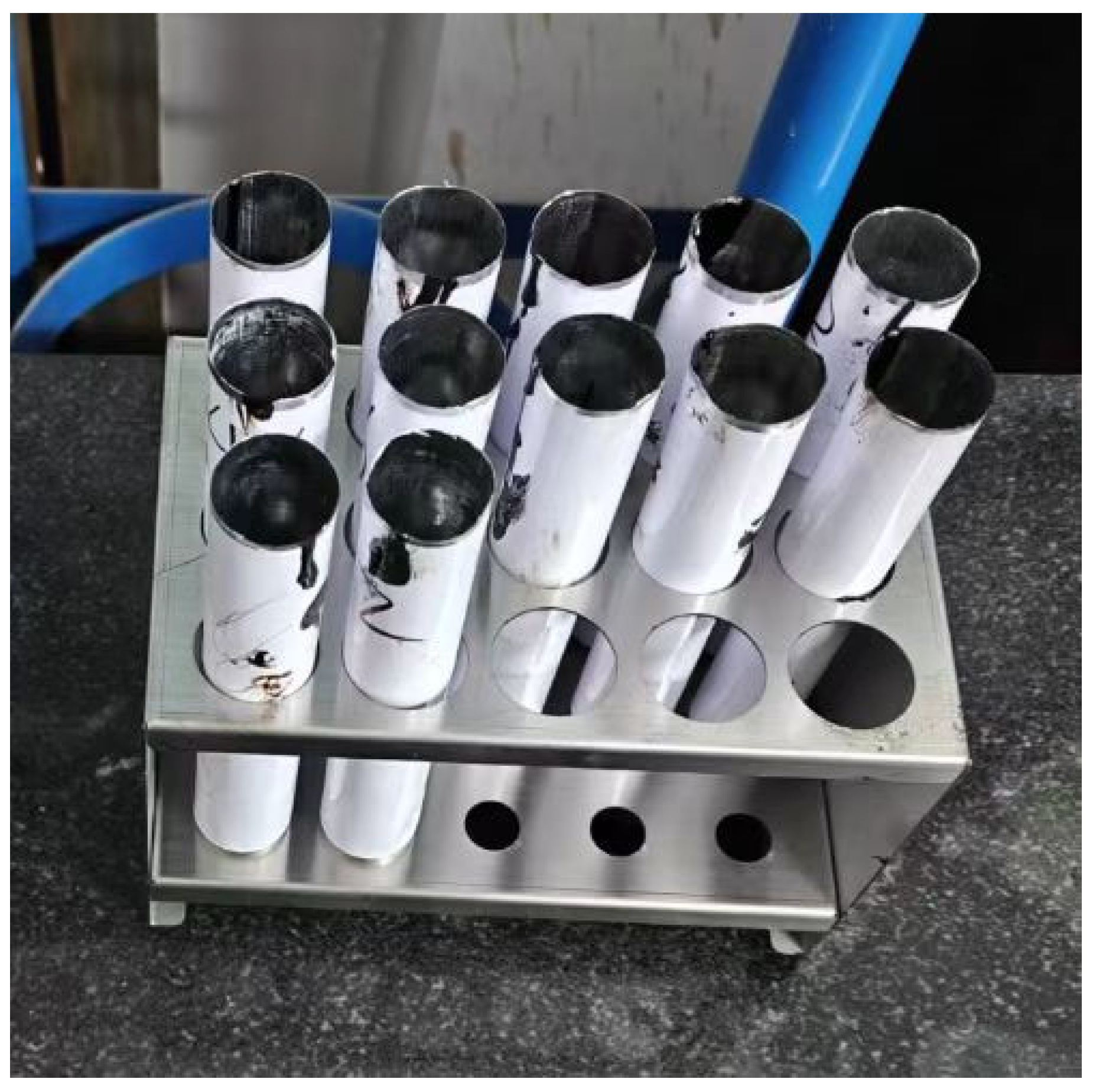
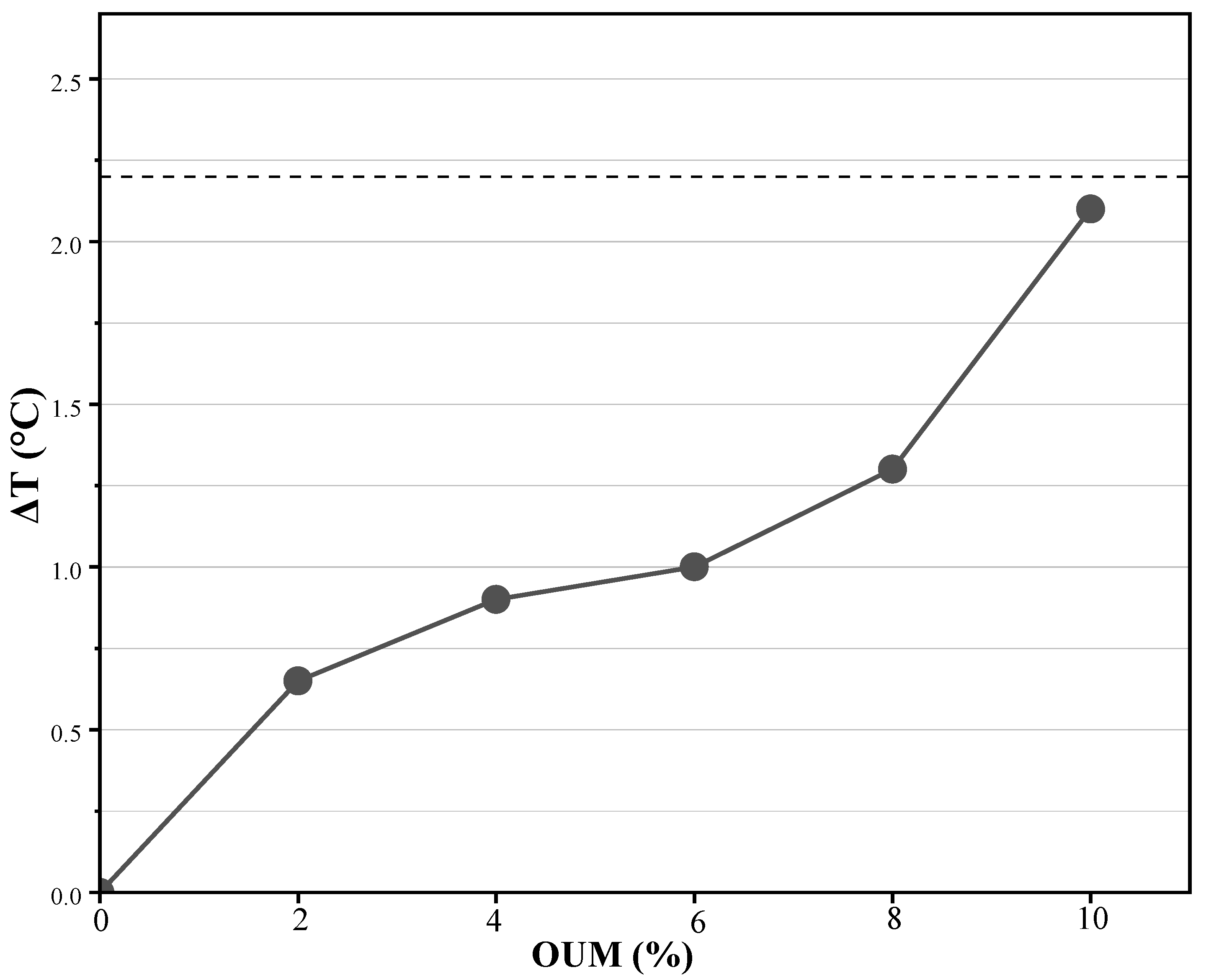
| Property | Penetration | Ductility | Softening Point | Dynamic Viscosity | Flash Point | Penetration Index PI |
|---|---|---|---|---|---|---|
| (25 °C/0.1 mm) | (15 °C/cm) | (°C) | (60 °C/Pa s) | (°C) | ||
| Requirement | 60–80 | ≥100 | ≥46 | ≥180 | ≥260 | −1.5–+1.0 |
| Result | 71 | >100 | 48 | 223 | >300 | −0.87 |
| Test Item | Melting Point (°C) | Tensile Strength (MPa) | Water Absorption 24 h (%) | Specific Gravity | Rupture Force (N) |
|---|---|---|---|---|---|
| Result | 155 | 3.45 | 8.2 | 0.91 | 19.38 |
| Standard | ASTM-D7138-16 | ASTM-D638-14 | ASTM-D570-98 | ASTM-D792-20 | ASTM-D638-14 |
Disclaimer/Publisher’s Note: The statements, opinions and data contained in all publications are solely those of the individual author(s) and contributor(s) and not of MDPI and/or the editor(s). MDPI and/or the editor(s) disclaim responsibility for any injury to people or property resulting from any ideas, methods, instructions or products referred to in the content. |
© 2025 by the authors. Licensee MDPI, Basel, Switzerland. This article is an open access article distributed under the terms and conditions of the Creative Commons Attribution (CC BY) license (https://creativecommons.org/licenses/by/4.0/).
Share and Cite
Abdelmagid, A.A.A.; Jin, G.; Chen, G.; Ijaz, N.; Huang, B.; Li, Y.; Idriss, A.I.B. Characterization of Asphalt Binder Properties Modified with One-Time Use Masks: Zero Shear Viscosity, Fatigue Life, and Low-Temperature Performance. Materials 2025, 18, 4861. https://doi.org/10.3390/ma18214861
Abdelmagid AAA, Jin G, Chen G, Ijaz N, Huang B, Li Y, Idriss AIB. Characterization of Asphalt Binder Properties Modified with One-Time Use Masks: Zero Shear Viscosity, Fatigue Life, and Low-Temperature Performance. Materials. 2025; 18(21):4861. https://doi.org/10.3390/ma18214861
Chicago/Turabian StyleAbdelmagid, Alaaeldin A. A., Guanghui Jin, Guocan Chen, Nauman Ijaz, Baotao Huang, Yiming Li, and Aboubaker I. B. Idriss. 2025. "Characterization of Asphalt Binder Properties Modified with One-Time Use Masks: Zero Shear Viscosity, Fatigue Life, and Low-Temperature Performance" Materials 18, no. 21: 4861. https://doi.org/10.3390/ma18214861
APA StyleAbdelmagid, A. A. A., Jin, G., Chen, G., Ijaz, N., Huang, B., Li, Y., & Idriss, A. I. B. (2025). Characterization of Asphalt Binder Properties Modified with One-Time Use Masks: Zero Shear Viscosity, Fatigue Life, and Low-Temperature Performance. Materials, 18(21), 4861. https://doi.org/10.3390/ma18214861








